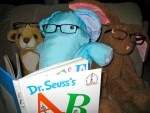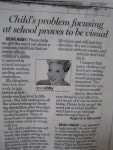Vision & Learning, and Choosing An Eye Doctor
Every year in the U.S., up to 20% of elementary school children start school with undetected vision problems. With 80% of learning occurring through vision, large numbers of children are likely performing below their full potential in school.
In a recent study in the US, several thousand elementary school aged children were given full vision evaluations. As is normally the case in these studies, about 20% of the children were found to have significant vision problems that could interfere with their school performance. The new and troubling finding in this study was that most of these kids had recently passed a pediatrician vision screening.
The problem with pediatrician vision screenings is that they screen only for blurry far away vision (nearsightedness). Ironically, most often, nearsighted children are the ones who do best in school, because they have the best near reading comfort and concentration, where most learning occurs. The children who struggle in school have poor near vision comfort, concentration, and eye coordination. This group will pass the pediatrician vision screening and likely be advised that further vision testing is not required.
A common outcome of this advice is a child who struggles with basic learning skills such as reading comprehension and attentiveness. The parents, assuming vision is normal, will resort to tutoring, therapy, and/or attention improvement medications. When these approaches are unsuccessful, the parent and child may finally end up getting a complete vision evaluation, but the first few years of school often set the pattern for a child’s attitude towards school and learning and can be difficult to regain.
As a result of this study, many states now require a complete vision evaluation by a vision specialist prior to starting school. California is often behind in this type of legislation, so it is up to you to make a good preventative decision to assure your child’s success in school.
The current American Optometric Association recommendation for first vision exams is six months of age. This is designed to catch cases of lazy eye (amblyopia) when it can still be treated. I would advise this for all children with vision problems that run in the family or if you observe any unusual vision behavior in your child. Otherwise, do not let your child’s 3rd birthday pass without a complete vision evaluation by a vision specialist.
Finally, in choosing a vision specialist, your best choice is a developmental optometrist, who is a specialist in determining that your child’s complete visual system has matured to the appropriate level for his or her age. An ophthalmologist can be the correct choice if your child needs surgical eye care. They are best used by referral, and not for initial evaluations.
When a Bright Child Has Trouble Reading
Even children with "perfect eyesight" can suffer from vision disorders that thwart their effort to learn and can hinder their performance and possibly behavior in school.
Underachievement is a slippery concept. You have the feeling your child isn't doing as well as she/he ought. Maybe it's the teacher. Maybe it's the school. Maybe it's the age, or a stage. Maybe the work is too hard. Maybe you're expecting too much. These doubts keep many a worried parent sitting on the fence waiting to see if next year will be better.
It is estimated that, nationwide, one of every six children is two or more grade levels behind in reading. Optometrists find that some 80 percent of these "slow" readers have difficulty in eye control and coordination. Parents and teachers may label them lazy, unmotivated, looking for attention, or "not good students". The children usually come to the conclusion that they're different or dumb, and may become drop-outs--not only from school but from a full life, yet 90 percent of these particular visual problems can be "cured"--quickly and forever!
*A book held very close to the eyes--only seven or eight inches away
*Pages counted before reading, only shorter pieces considered
*The head moves back and forth while reading, instead of just the eyes
*Finger is used to trace lines while reading
*Subvocalization during reading: murmuring or silent moving of lips
*Complaints of blurring, double-vision or headaches
*Short attention span while reading--child is quickly fatigued
*Homework takes hours and hours, when it shouldn't
*Child seems to read well enough but recalls only portions or has spotty understanding; whereas, if material is read aloud, child has virtually total recall
*The child is well-coordinated, yet has trouble with ball games (softball, tennis, kickball)
*Schoolwork that depends to a large extent upon reading--history or English--is difficult, while subjects such as math and science are learned easily

